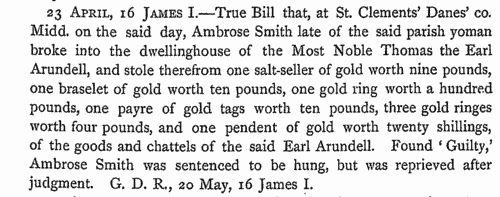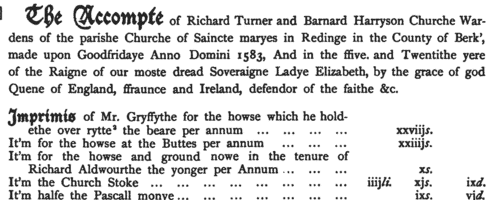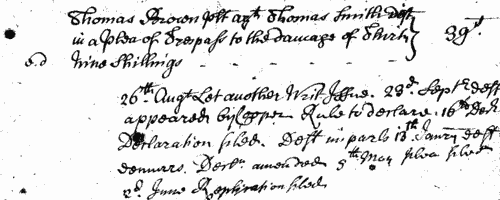Harryson Surname Ancestry ResultsOur indexes 1000-1999 include entries for the spelling 'harryson'. In the period you have requested, we have the following 89 records (displaying 71 to 80): Single Surname Subscription | | | Buying all 89 results of this search individually would cost £512.00. But you can have free access to all 89 records for a year, to view, to save and print, for £100. Save £412.00. More... |
These sample scans are from the original record. You will get scans of the full pages or articles where the surname you searched for has been found. Your web browser may prevent the sample windows from opening; in this case please change your browser settings to allow pop-up windows from this site. St Albans Archdeaconry Marriage Licences: Bridegrooms
(1624)
Southern Hertfordshire lay in the archdeaconry of St Albans. Marriage licences registered in the archdeaconry act books from 1584 to 1639, and surviving bonds and allegations from 1611 to 1620, 1625 to 1627, 1633 to 1637 and 1661 to 1668 were abstracted by A. E. Gibbs and printed in volume 1 of the Herts Genealogist and Antiquary published in 1895. Both the act books and the bonds normally give full name and parish of bride and groom, and state whether the bride was maiden or widow. A widow's previous married surname is given, not her maiden surname. Occasionally (doubtless when a party was under age) a father's name is given. The later act books sometimes stated at what church the wedding was intended to be celebrated. The marriage bonds give the name of the bondsman or surety. The surety's surname is often the same as the bride or groom, and doubtless in most cases the bondsman was a father or close relative; but a few innkeepers and other tradesmen of St Albans also undertook this duty.HARRYSON. Cost: £4.00.  | Sample scan, click to enlarge

| Middlesex Sessions
(1603-1625)
Incidents from the Middlesex Sessions Books. These are abstracts of sessional orders, minutes of criminal cases, memoranda and other entries of record taken from the three volumes of Gaol Delivery Register, four volumes of Sessions of Peace Register and two volumes of Process Books of Indictments for the county of Middlesex from the reign of king James I. The references at the end of each item indicate the volume in question, the abbreviations being G. D. for Gaol Delivery, S. P. for Sessions of Peace, and S. O. T. for Session of Oyer and Terminer; occasionally preceded by S. for Special or G. for general, or followed by R. for Roll or Reg. for Register. It should be noted that, in the case of 'true bills' or indictments, the abstract starts with the date on which the offence took place, the date of the conviction &c. being at the end of the entry.HARRYSON. Cost: £4.00.  | Sample scan, click to enlarge

| Liegemen and Traitors, Pirates and Spies
(1625-1626)
The Privy Council of Charles I was responsible for internal security in England and Wales, and dealt with all manner of special and urgent matters
HARRYSON. Cost: £4.00.  | Sample scan, click to enlarge

| Inhabitants of Cambridge
(1504-1635)
Cambridge comprised fourteen ancient parishes, plus the university (which was extra-parochial), in the diocese of Ely. The church of St Mary the Great (as opposed to St Mary the Less) in the Market Place (juxta forum) has churchwardens' accounts surviving from 1504 onwards. Those from 1504 to 1635 were transcribed by J. E. Foster for the Cambridge Antiquarian Society and published in 1905. The two churchwardens were chosen annually: the previous year's churchwardens each chose another parishioner: those two then each chose three other parishioners: the resulting eight then chose the new year's churchwardens, the wardens of the Light of the Rood, and the wardens of the Mass of Jesus. Auditors were also chosen, usually out of the eight, to examine all the wardens' accounts at the end of the year. The churchwardens' accounts are largely concerned with the costs of repair of the church and its furnishings, and include the names of tradesmen and workmen. Each Easter a rate called Easter money was raised was raised from all householders in the parish, and additional rates are occasionally levied for unusual expenses, such as steeple reconstruction. These 'Easter book' lists give a complete list of householders for the parish, excepting the poor. The church's income also included the rents from some houses in the parish, and the names of the tenants appear. The offices of the Light of the Rood and the Mass of Jesus were abolished during the Reformation. The accounts of the Light of the Rood, i. e., for candles burnt before the crucifix, often include a list of sums received for funerary diriges (dirges) for the year, from which the year of death of the more prosperous parishioners can be traced in this early period. HARRYSON. Cost: £4.00.  | Sample scan, click to enlarge

| Inhabitants of Reading in Berkshire
(1550-1667)
The borough of Reading in Berkshire comprised three ancient parishes - St Giles, St Lawrence and St Mary. The churchwardens' accounts of Reading St Mary from 1550 to 1667 were transcribed by Francis N. A. Garry and A. G. Garry and published in 1893. The accounts, usually signed off by the two churchwardens and two surveyors of the highways for the year, listed the income and expenditure of the church. Income included annual payments for seats in the pews; rents from church property; fees for the use of the pall and for tolling the knell (knill) at funerals, and for opening graves; and sums received for 'gatherings', i. e. money gathered from communicants at Easter, Hocktide, Mayday, Hallowmas, Christmas and Whit. Expenditure was largely on maintaining the church fabric, and paying the minor officials - most of the names found on this side of the account are of local workmen busy with repairs.HARRYSON. Cost: £4.00.  | Sample scan, click to enlarge

| Burgesses of Preston, Lancashire, and other members of Preston guild merchant
(1397-1682)
Freedom of the borough of Preston was necessary to trade in the town. The guild merchant maintained rolls of the burgesses, which were renewed every Preston guild, held every twenty years. The surviving rolls from 1397 to 1682 were edited by W. Alexander Abram, and published by the Lancashire and Cheshire Record Society in 1884 (volume ix). Each roll contains, firstly, a list of In-Burgesses, i. e., burgess inhabitants of the town, with the names of any adult sons eligible by way of inheritance to the freedom; then Foreign Burgesses (Burgenses Forinseci), i. e., those persons living outside the town who had acquired the freedom, plus the names of any adult sons; finally, there is a list of those who were not burgesses by inheritance, but had purchased freedom of the town. The only women to appear in these lists are three ladies in 1397, who were perhaps widows of burgesses. The text covers the rolls for the guilds merchant held in 1397 (20 Richard II: pages 1 to 7), 1415 (7 Henry V: 7-11), 1459 (37 Henry VI: 11-15), 1542 (34 Henry VIII: 15-19), 1562 (4 Elizabeth: 20-31), 1582 (24 Elizabeth: 31-46), 1602 (44 Elizabeth: 46-65), 1622 (20 James I: 65-94), 1642 (18 Charles I: 94-123), 1662 (14 Charles II: 123-159), and 1682 (34 Charles II: 160-202).HARRYSON. Cost: £4.00.  | Sample scan, click to enlarge

| East Cheshire plaintiffs and defendants
(1725)
Macclesfield Hundred court, held at Macclesfield every fourth Monday for the trial of civil causes, had jurisdiction over Bredbury, Brinnington, Bramhall, Fulshaw, Cheadle, Handforth, Dukinfield, Etchells, Hyde, Northenden, Romiley, Stockport, Werneth, Mottram (in Longdendale), Nether Alderley, Over Alderley, Birtles, Bollin Fee, Newton by Butley, Capesthorne, Chelford, Old Withington, Chorley, Eaton, Fallibroome, Henbury, Marton, Mottram St Andrew, Worth, Woodford, Pownall Fee, Snelson, Siddington, Somerford Booths, Lower Withington and Great Warford, all in east Cheshire. Whenever an action continued, through a series of writs or actual appearances, through subsequent sittings of the court, these were all entered on the same page, so that each is the full record of the particular action through to its conclusion. Some actions will have been settled 'at the court door', in which case nothing more is recorded than the names of plaintiff and defendant, the nature and value of the action. Addresses and occupations are not usually given for plaintiff or defendant, but are stated for bail sureties. 5 September 1725HARRYSON. Cost: £10.00.  | Sample scan, click to enlarge

|  Apprentices registered at Lincoln
(1723-1726) Apprentices registered at Lincoln
(1723-1726)
Apprenticeship indentures and clerks' articles were subject to a 6d or 12d per pound stamp duty: the registers of the payments usually give the master's trade, address, and occupation, and the apprentice's father's name and address, as well as details of the date and length of the apprenticeship. There are central registers for collections of the stamp duty in London, as well as returns from collectors in the provinces. These collectors generally received duty just from their own county, but sometimes from further afield. Because of the delay before some collectors made their returns, this register includes indentures and articles from as early as 1722. (The sample entry shown on this scan is taken from a Norfolk return)HARRYSON. Cost: £8.00.  | Sample scan, click to enlarge

| East Cheshire plaintiffs and defendants
(1727)
Macclesfield Hundred court, held at Macclesfield every fourth Monday for the trial of civil causes, had jurisdiction over Bredbury, Brinnington, Bramhall, Fulshaw, Cheadle, Handforth, Dukinfield, Etchells, Hyde, Northenden, Romiley, Stockport, Werneth, Mottram (in Longdendale), Nether Alderley, Over Alderley, Birtles, Bollin Fee, Newton by Butley, Capesthorne, Chelford, Old Withington, Chorley, Eaton, Fallibroome, Henbury, Marton, Mottram St Andrew, Worth, Woodford, Pownall Fee, Snelson, Siddington, Somerford Booths, Lower Withington and Great Warford, all in east Cheshire. Whenever an action continued, through a series of writs or actual appearances, through subsequent sittings of the court, these were all entered on the same page, so that each is the full record of the particular action through to its conclusion. Some actions will have been settled 'at the court door', in which case nothing more is recorded than the names of plaintiff and defendant, the nature and value of the action. Addresses and occupations are not usually given for plaintiff or defendant, but are stated for bail sureties. 2 October 1727HARRYSON. Cost: £10.00.  | Sample scan, click to enlarge

| East Cheshire plaintiffs and defendants
(1738)
Macclesfield Hundred court, held at Macclesfield every fourth Monday for the trial of civil causes, had jurisdiction over Bredbury, Brinnington, Bramhall, Fulshaw, Cheadle, Handforth, Dukinfield, Etchells, Hyde, Northenden, Romiley, Stockport, Werneth, Mottram (in Longdendale), Nether Alderley, Over Alderley, Birtles, Bollin Fee, Newton by Butley, Capesthorne, Chelford, Old Withington, Chorley, Eaton, Fallibroome, Henbury, Marton, Mottram St Andrew, Worth, Woodford, Pownall Fee, Snelson, Siddington, Somerford Booths, Lower Withington and Great Warford, all in east Cheshire. The sample scan is taken from 29 July 1734: as in this case, whenever an action continued, through a series of writs or actual appearances, through subsequent sittings of the court, these were all entered on the same page, so that each is the full record of the particular action through to its conclusion. Some actions will have been settled 'at the court door', in which case nothing more is recorded than the names of plaintiff and defendant, the nature and value of the action. Addresses and occupations are not usually given for plaintiff or defendant, but are stated for sureties. This index covers plaintiffs, defendants and sureties, but not court officials or attorneys. This index is for the court held on 24 July 1738HARRYSON. Cost: £10.00.  | Sample scan, click to enlarge

|
Research your ancestry, family history, genealogy and one-name study by direct access to original records and archives indexed by surname.
|













